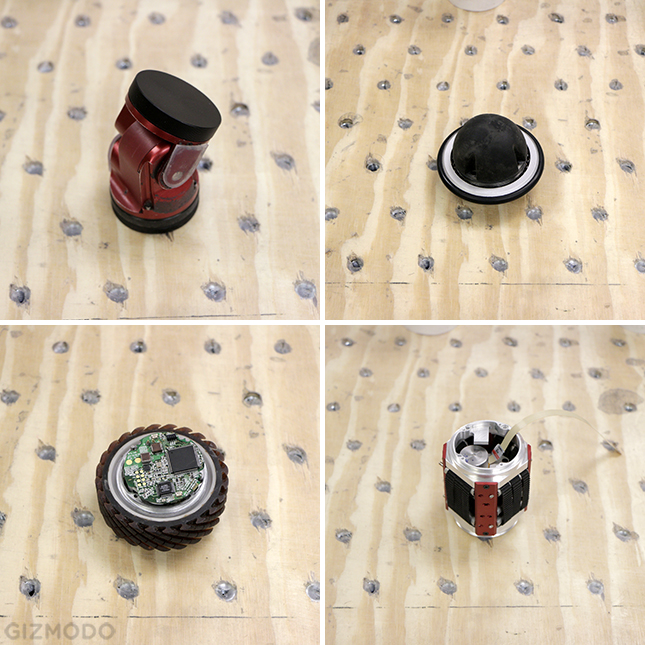A snakebot recently crawled up my leg. The engineers sort of grinned while I grimaced, wondering if I should try to attack it or cry for help, an impulse that comes from watching too many sci-fi movies, I guess. I expect most robots to destroy me, but these snakebots are designed to do the opposite. And they could change robotics as we know it.
Robotics as we know it is a highly proprietary and supposedly dangerous endeavour. Snakebots — modular robots that look and move like snakes — aim to break both of these conventions, by making robots both reprogrammable and responsive.
People are afraid of robots not just because scifi movies tell us to fear them, but also because robots are scary strong machines made of sharp metal parts and powered by software that can inevitably malfunction. Conventional robots tend to lack the ability to feel things which is why they tend to be so scary. But the snakebots being developed at Carnegie Mellon University can “feel” — they’re responsive to touch.
Today’s robots also tend to be designed for one very specific purpose. So a company may spend hundreds of thousands of dollars to design a machine to do one task, and when that task is no longer essential, the robot’s rendered useless. These slithering modular machines, on the other hand, are designed to transform and be repurposed with new capabilities.
When the snakebot crawled up my leg, Howie Choset, an associate professor at Carnegie Mellon’s Robotics Institute, was explaining how these modular robots are designed to shift the emphasis in robotics from expensive hardware to easy-to-program software. So to make a snakebot, you simply connect several different, interchangeable components that allow the robot to move a certain way, and the software takes care of the rest.
An All-Purpose Robot
Howie and his team want to change the basic conventions of robotics. In other words, let’s stop building expensive robots for a single purpose and start building modular robots for any purpose. “In a sense, we’re demonstrating the ability to program and reprogram robots,” Howie told me. “This way, the engineers can focus on generating a capability.”
This was news to me. I’d heard of Howie’s snakebots before but mainly regarding how the biomimetic movement could send robots into places where robots haven’t been able to go before, like pipes or certain kinds of disaster zones. But the ultimate vision is much more ambitious.
Now that the team has conquered some of the basic engineering challenges of building responsive, versatile hardware, they’re starting to take the snakebots apart. In other words, they’re taking that perfected hardware and making it more modular so that the components can be rearranged into new forms, forms that are more advanced that a simple snakebot.
Each snakebot is made up a string of innovative modules that allow for many degrees of freedom. That’s how they’re able to wiggle across the floor like snakes. However, the team has been busy modifying those modules so that they do more than just wiggle. Below is a selection of modules. The one on the top left acts as a hinge, while the one on the top right works like a foot. The bottom left module is basically a wheel, while the bottom left is equipped with multidirectional treads. Other modules include a network camera and even a claw that can grasp objects.

Due to unique springs inside each module they can respond to pressure and essentially feel. In other words, if a snakebot is crawling up your leg, it knows not to squeeze too hard, and if the robot’s climbing across uneven terrain, it knows when it’s hit a dead end. This not only makes different types of locomotion possible, it enables the robots to take on countless new capabilities with the countless different arrangements of the modules.
Meet the Snake Monster
Howie’s team showed off this evolution earlier this year when they unveiled the snake monster. This six-legged creature hobbled forward like an insect rather than a snake, and showed how the snakebot modules could be connected to a body and totally repurposed.
It’s pretty crazy to see the snake monster in action:
As you can see, the robot hexapod is completely responsive. The same unique spring system that makes the snakebot so versatile makes the snake monster move less like a robot and more like an animal. The added stability and flexibility of hexapod robots is widely known. The real innovation with Howie’s snake monster is the fact that the robot can be disassembled and reassembled into a different shape within a matter of minutes.
The team is currently working on taking the parts from the snake monster and creating a bi-pedal robot. Perhaps it will even perform like a simplified version of the famous ATLAS humanoid robot. All of the hardware is already there, Howie says. It’s just a matter of building the right software now. The unique features of the modules also make these robots extra safe, since they’re so responsive. “So in a sense, we’re creating more jobs, where people and machinery can work side-by-side,” Howie told me.
A Future Full of Simple Transformers
You can imagine where this is going. Howie says the software side of things is getting easier and easier, so eventually pretty much anyone would be able to program one of his transforming snakebots. And, perhaps most importantly, people should be able to program these robots on the fly. It should take minutes or hours, not days or months, like current robotics software.
The vision is consistent with Carnegie Mellon’s now legendary history of building simple, useful robots. Meanwhile, the safety aspect meshes nicely with the university’s Soft Machines Lab, where Howie’s colleagues are working on approachable, “plush robots” that you could hug and cuddle. And while roboticists around the world have been developing snakebots since the 1990s, the new capabilities of Howie’s modular system is speeding the pace of innovation. As proof of his lab’s fast-and-simple concept, one graduate student reprogrammed a snakebot to feed him food in just an hour:
Robots-to-go is a fantastic idea with seemingly endless applications. Some at Carnegie Mellon envision the technology being adapted for use in medical devices. Others see it being useful in factories or archaeological digs. And, perhaps obviously, there are military applications.
Since it’s easy enough to screw a camera on the front, the versatile snakebots would make great spies. A soldier could ostensibly pack up the various modules needed for a recon robot and head out into the field. Depending on the mission, the robot could be reconfigured or reprogrammed to fit the soldier’s needs. Then, the modules go right back into the backpack and right back to base where they will await their next scouting mission.
That said, I like to think of the modular snakebot system as the vanguard of democratic robotics. Versatile hardware and easily programmed software will make this technology more accessible to more people. Like Google’s modular Ara phone — which the military also loves — anybody with basic tech skills could assemble and reassemble a device on the fly.
For now, Howie is focused on putting these robots to work. “We believe the future of this modularity lies in manufacturing,” he said. “We’re going to make a robot that’s cheaper and easier to use but also easier to program and operate.”
Sounds good to me. Now, I just need to know when these bad boys will go on sale for the rest of us. I want a robot to brush my teeth, please.
